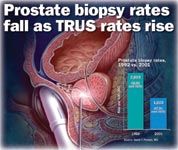Article
Prostate biopsy rates fall as TRUS rates rise
San Antonio--The epidemiologic confusion wrought by the introduction of the PSA test in the 1990s appears to have settled down at the opening of the new century, according to a study of biopsy patterns presented here at the 2005 AUA annual meeting. Biopsy rates that had soared early in the decade have fallen dramatically, and the incidence of prostate cancer has stabilized.

"Doctors now are selecting more appropriate patients for biopsy, as evidenced by the observation that, while the biopsy rates are falling, the incidence of prostate cancer detection has remained stable since 1995. I think we are getting better at what we do, and we are using the technology more appropriately," lead author David F. Penson, MD, MPH, associate professor at the University of Southern California Norris Cancer Center, Los Angeles, told Urology Times.
Dr. Penson and his colleagues from the Urologic Diseases in America Project queried the national Medicare public use files to determine the rate of biopsies per 100,000 men and the percentage of biopsies guided by transurethral ultrasound. The effort required sifting through 1.3 million records to determine the rates during the years 1992, 1995, 1998, and 2001.
Technology increasingly accepted
Technology became increasingly accepted during the 9-year period. The percentage of transrectal ultrasound-guided biopsies nearly doubled. In 1991, 36.9% of all biopsies used TRUS. This percentage rose to 67.9% by 2001.
"The year 1992 is the year PSA testing reached plateau levels nationwide. [Physicians] were biopsying everyone at that point, and that was probably appropriate because most of those patients had PSAs that exceeded 4.0 ng/mL. But as we moved through the '90s, biopsy rates began to fall as the pool of cancers began to be drained," Dr. Penson said. "The message is that doctors are now selecting more appropriate patients for biopsy. That conclusion can be derived from the observation that, while the biopsy rates are falling, the incidence of the cancer is stabilizing."
Regional differences
The study also noted significant differences in biopsy rates and TRUS application rates by region. For instance, in 1992 a gap of approximately 10% was seen between the percentages of TRUS-guided biopsies conducted in the Midwest (35.8%) and in the West (45.5%). This gap narrowed to nearly 4% by 2001 (Midwest, 68.1%; West, 72.4%). Dr. Penson noted that, owing to the size of the sample (1.3 million), all findings achieved significance.
He was unable to explain why different regions of the country seem to apply technologies differently.
"I think there are age differences among the regions, and that may have something to do with it, but there is no question that doctors in different parts of the country do practice differently," Dr. Penson explained, citing several other studies examining regional utilization of different medical technologies.
The next step in the ongoing analysis is to look at detection rates and, perhaps, the nature of the biopsy procedure itself. To do so, Dr. Penson said he will have to turn to data sets other than those from Medicare. He is also interested in identifying changes in the biopsy procedure.
"I suspect the primary procedure is no longer sextant, but is not quite 12. I suspect around 8 to 10 cores are being taken now, but I am just guessing," he said.





